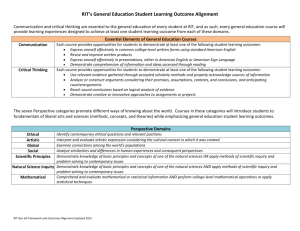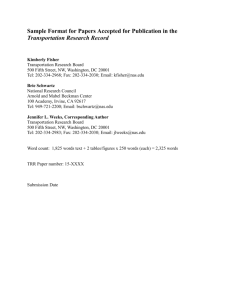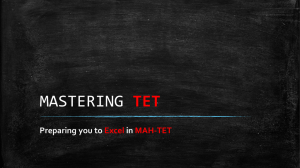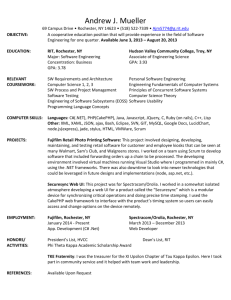SBV dissertation Template - MGMCRI Post Graduate Portal
advertisement
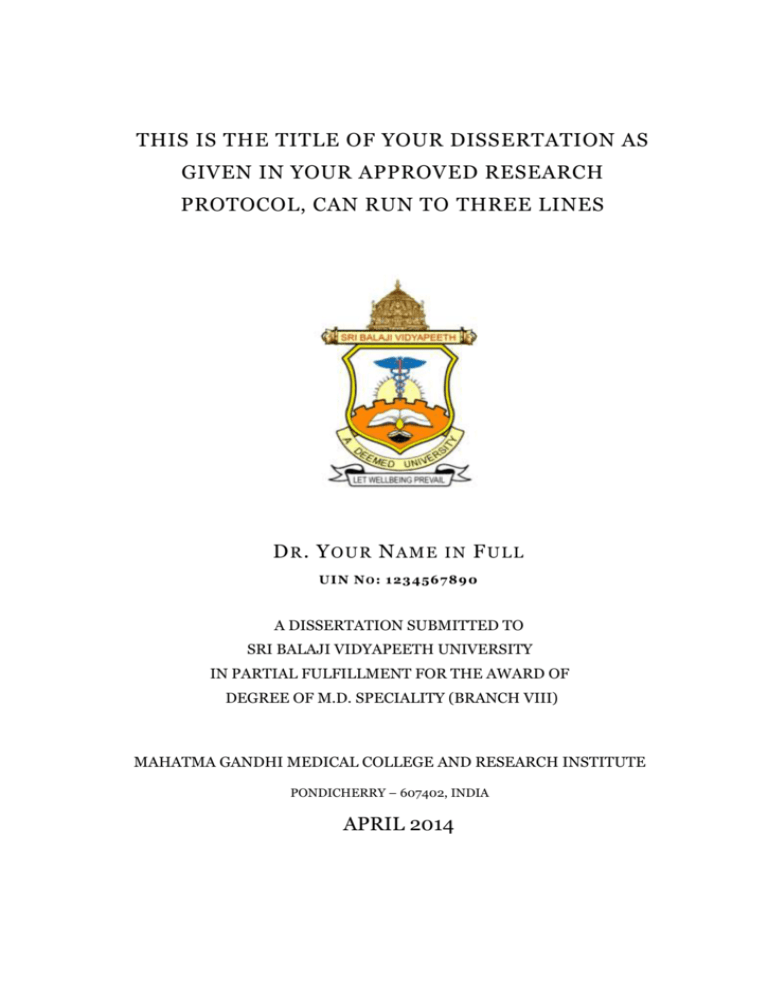
THIS IS THE TITLE OF YOUR DISSERTATION AS GIVEN IN YOUR APPROVED RESEARCH PROTOCOL, CAN RUN TO THREE LINES D R . Y OU R N AME IN F U LL UI N N O : 1 23 456 7 89 0 A DISSERTATION SUBMITTED TO SRI BALAJI VIDYAPEETH UNIVERSITY IN PARTIAL FULFILLMENT FOR THE AWARD OF DEGREE OF M.D. SPECIALITY (BRANCH VIII) MAHATMA GANDHI MEDICAL COLLEGE AND RESEARCH INSTITUTE PONDICHERRY – 607402, INDIA APRIL 2014 MAHATMA GANDHI MEDICAL COLLEGE AND RESEARCH INSTITUTE, PONDICHERRY -607402 CERTIFICATE This is to certify that the dissertation entitled “FULL TITLE OF YOUR DISSERTATION AS IT WAS APPROVED IN YOUR RESEARCH PROTOCOL WITHOUT CHANGE” is a bonafide record of original work carried out by DR. NAME IN FULL, UIN: 1234567890 in the Department of Speciality, under our guidance and supervision during the period of his post graduate study for M.D. Radio-diagnosis from April 2009 to March 2012. Dr. PRIMARY GUIDE Professor and Head of Department of Speciality Guide Dr. CO GUIDE ONE Associate Professor of Speciality Co-guide Dr. HEAD OF DEPARTMENT Professor of Speciality Head, Department of Prof. ANANTHAKRISHNAN N DEAN – RESEARCH & PG STUDIES Sri Balaji Vidyapeeth. i ACKNOWLEDGEMENTS You can start by thanking your Guide & Co-guide(s), broadly for their guidance, inspiration, etc and then narrow down to express your gratitude for specific help or assistance you had received. Indicative and specific mentioning of help rendered is generally considered more attributive, appreciative and thankful. Gratitude to help received from other staff of MRD, Nursing and various other departments could be mentioned in two or three lines. If the thesis required specific nursing assistance, it would be a good idea to thank the Nursing staff in a separate line. (if applicable) It is very important, highly recommended and imperative that your Patient Volunteers be profusely thanked for their voluntary participation in your thesis. If the study involved children, their parents can be thanked for their consent to enrol their children in the study. You may thank people who had helped you with particular jobs, such as formatting, statistics, etc. I am indebted to my fellow post-graduate residents, my Assistant and Associate Professors for all the help and assistance I have received from them over last two years. I am thankful to the Assistants and Technicians of the Department of Speciality who have gone out of their way to help me. I thank the Chairman, Vice Chancellor, Dean – Research and Postgraduate Studies, Deputy Director and Medical Superintendent of our Medical College and Hospital for their every help in making this Thesis possible. Some choose to include family members, spouse and parents in the Acknowledgements: you have the freedom to do so. ii TABLE OF CONTENTS Certificate...................................................................................................................... i Acknowledgements ...................................................................................................... ii Table of Contents ........................................................................................................ iii Abbrevations and Acronyms ...................................................................................... iv 1 Introduction ......................................................................................................... 1 2 Aims and Objectives ........................................................................................... 1 3 Review of Literature ........................................................................................... 2 3.1 Header title style 2 ........................................................................................ 2 3.1.1 3.2 Header title style 5 ........................................................................................ 2 3.3 Section Breaks!!!! ......................................................................................... 2 3.4 Adding a Figure............................................................................................. 2 3.5 Adding a Table .............................................................................................. 3 3.6 Updating your TOC and Lists of Figures and Tables ................................... 4 3.7 Adding a Table in Landscape Orientation .................................................... 5 3.8 What will help you with your format check? ................................................ 1 3.9 Avoid these common mistakes! .................................................................... 1 3.9.1 4 Formatting that you CAN change .......................................................... 2 Subjects and Methods ......................................................................................... 3 4.1 Brief explanation of the Procedure ............................................................... 3 4.2 Technique and Protocol in sop style ............................................................. 3 4.2.2 4.3 Imaging Technique SOP ........................................................................ 4 Potential Pitfalls and Notes: .......................................................................... 4 4.3.1 SOMe prominent Issue: ......................................................................... 4 4.4 Data Collection.............................................................................................. 4 4.5 Statistical Methods ........................................................................................ 4 4.5.1 5 Header title style 3 ................................................................................. 2 Bland – Altman Plot ............................................................................ 6 Results ................................................................................................................. 6 5.1 Demographic Data ........................................................................................ 6 5.2 Bland Altman Analysis ................................................................................. 7 6 Discussion ........................................................................................................... 8 7 Conclusion........................................................................................................... 8 8 Abstract ............................................................................................................... 8 9 References ........................................................................................................... 8 iii Appendices…………………………………………………………add manually LIST OF FIGURES Figure 1: Demonstration Duck. Frequently used by dissertation & thesis template authors to demonstrate appropriate line spacing for figure captions. ............ 3 Figure 2: Graph 7 Figure 4: Demonstration Donkey ................................................................................ 1 Figure 6-2 - Bland and Altman plot of the variation between Radiography and Ultrasonography assessments. The mean indicates the mean difference, with the 95% limits of agreement. ......................................................................... 7 LIST OF TABLES Table 1: Loka and Terno. Note that this very long caption is single spaced both in the text and in the list of tables. ................................................................................... 3 Table 2: Animal Damage ............................................................................................. 8 ABBREVATIONS AND ACRONYMS AAM ALARA ASM BAA BAE BEIR CASAS CR CROI CT D DXA Active appearance model As low as reasonably achievable Active Shape Models Bone Age Assessment Bone Age Estimation Biological Effects of lonizing Radiations Computer-assisted Skeletal Age Scores Computed radiography Carpal region of interest Computed Tomography Distal Dual energy X-Radiography iv EI EMROI GHD GP GVF Gy HIV ICRP kHz kVp LNT MA MC MRI P PACS R ROI RUROI RUS RWT SD SM SVD TW2 TW3 U US US USG Exposure Index Epiphyseal Metaphyseal Regions of interest Growth Hormone Deficiency Greulich Pyle Gradient Vector Flow gray - a measure of radiation dose Human Immunodeficiency Virus International Commission on Radiological Protection kilo Hertz peak kilovoltage applied to an x-ray tube Linear-no-threshold model Milliamperage Metacarpal Magnetic Resonance Imaging Proximal Picture archiving and communication system Radius (Radial side) Region of Interest Radius-Ulna regions of interest Radius, Ulna and short bones Roche–Wainer–Thissen method Standard Deviation Skeletal Maturity Simple Vaginal Delivery Tanner and Whitehouse version 2 Tanner and Whitehouse version 3 Ulna (Ulnar side) Ultrasonography Ultrasound Ultrasonography IMPORTANT INSTRUCTION: PLEASE DO NOT ADD EMPTY PAGES WITH TITLES SUCH AS ‘INTRODUCTION’, ETC. AS PLACEHOLDERS. EVERY PAGE OF THE DISSERTATION SHOULD BE MEANINGFUL AND SHOULD CONTAIN ESSENTIAL DATA OR SCIENTIFIC MATERIAL. v 1 INTRODUCTION Introduction goes here 2 AIMS AND OBJECTIVES 1. Aim One. 2. Aim Two. 1 3 REVIEW OF LITERATURE 3.1 HEADER TITLE STYLE 2 3.1.1 HEADER TITLE STYLE 3 3.1.1.1 HEADER TITLE STYLE 4 3.2 HEADER TITLE STYLE 5 3.2.1.1.1.1 Header title style 6 3. 2. 1 .1 .1 . 1. 1 H E AD E R T I T L E S Y T L E 7 3.3 SECTION BREAKS!!!! This template has most of the formatting done for you. However, as you add your content, there are some things you should be aware of. First, in the Insert menu, there is an option break… This was used in this template to insert section break-next page between chapters in order for footnote numbering to restart. This is also how page numbering has restarted from the introduction page (roman numerals were used in the previous section containing table of contents, acknowledgement etc.) 3.4 ADDING A FIGURE To add a figure, in this case a clipart duck, use the insert menu to add a picture. After it is inserted, right click on the image and choose Format Picture… In the Layout tab, choose In line with text. Next, center the image with the center button on the tool bar. Finally, right click on the image again and choose Caption… You should choose 2 Label: Figure and Position: Below selected item. In the top text area, type in a colon (:) and the information that you want to appear as a caption. The word Figure will be added automatically. At the top of the next page, you should see a well-formatted demonstration duck complete with caption. Figure 1: Demonstration Duck. Frequently used by dissertation & thesis template authors to demonstrate appropriate line spacing for figure captions. This figure is centered between margins. However, the left margin is 1.5 inches and the right margin is only 1 inch, so the figure appears offset somewhat. Note the single spaced caption. 3.5 ADDING A TABLE Adding a table in portrait page orientation is not difficult. To add a caption, highlight the entire table, right click and choose Caption…as you would with a figure. However, for tables, you should choose Label: Table and Position: Above selected item. Table 1: Loka and Terno. Note that this very long caption is single spaced both in the text and in the list of tables. Loka Lingva Auart Tereno North 11234 $35K 35-45 33% East 3342 $37K 32-41 22% South 2345 $39K 33-39 90% 3 Central 2345 $33K 22-33 44% West 15643 $37K 35-40 2% 3.6 UPDATING YOUR TOC AND LISTS OF FIGURES AND TABLES To update the table of contents, the list of figures or the list of tables (they are found back in the roman numeral pages,) go back to that TOC or list and right click on it. Choose Update field and then Update entire table. All page number references are inserted and/or updated automatically. Do this every time you open the document. Frequently (and especially for long documents) the TOC will “grab” page numbers before the whole document is loaded, which results in a wacky TOC. Ed te dignibh ea faccum ipsustrud dolor alit augue dolore veliquiscin euguero corpero odolum dolorem ing enisim1 eumsandiam ilis nullamc onullut dolore tie dolorem quat. Rit inim aliquisi tet, quam zzrit illanortisi. Ed te dignibh ea faccum ipsustrud dolor alit augue dolore veliquiscin euguero corpero odolum dolorem ing enisim2 eumsandiam ilis nullamc onullut dolore tie dolorem quat. Rit inim aliquisi tet, quam zzrit illanortisi. Duis non arcu vitae dolor porttitor commodo. Aenean malesuada augue a risus. Donec nisl. Nulla facilisi. Vestibulum ante ipsum primis in faucibus orci luctus et ultrices posuere cubilia Curae; Curabitur tristique nunc eu pede. Ut felis velit, aliquam id, luctus sit amet, laoreet vitae, lorem. Suspendisse potenti. Donec eu diam viverra mi imperdiet rutrum. In laoreet scelerisque enim. Donec blandit sapien vel est. 3 1 Rit inim ibid a lot. Rit inim ibid a lot. 3 Aybabtu 1723, nullarfarm tricky, corpero odolum dolorem ing enisim 3 eumsandiam ilis nullamc onullut dolore tie dolorem quat. Rit inim aliquisi tet, quam zzrit illanortisi. Ed te dignibh ea faccum ipsustrud dolor alit augue dolore veliquiscin euguero corpero odolum dolorem ing enisim 3 eumsandiam ilis nullamc onullut dolore tie dolorem quat. Rit inim aliquisi tet, quam zzrit illanortisi. corpero odolum dolorem ing enisim 3 eumsandiam ilis nullamc onullut dolore tie dolorem quat. Rit inim aliquisi tet, quam zzrit illanortisi. Ed te dignibh ea faccum ipsustrud dolor alit augue dolore veliquiscin euguero corpero odolum dolorem ing enisim3 eumsandiam ilis nullamc onullut dolore tie dolorem quat. Rit inim aliquisi tet, quam zzrit illanortisi. corpero odolum dolorem ing enisim 3 eumsandiam ilis nullamc onullut dolore tie dolorem quat. Rit inim aliquisi tet, quam zzrit illanortisi. Ed te dignibh ea faccum ipsustrud dolor alit augue dolore veliquiscin euguero corpero odolum dolorem ing enisim 3 eumsandiam ilis nullamc onullut dolore tie dolorem quat. Rit inim aliquisi tet, quam zzrit illanortisi. 2 4 3.7 ADDING A TABLE IN LANDSCAPE ORIENTATION Adding a table, figure or other content in landscape orientation is a little more tricky, as your page number must still appear as if you are in portrait orientation. To do this, you must insert two section break- next page (which is not just a page break, be careful that you get the one under section break types!) Go to the view menu and change to normal if you are not there already. You should see two double lines labeled Section Break (Next Page). Place your cursor between these section breaks and go to the file menu and choose Page Setup… You should chose landscape orientation, and make sure that your margins are as follows: top 1.5 inches, other sides 1inch. Also, be sure that you have chosen Apply to This section or you will make the rest of (or maybe all) your document landscape oriented. The next part, dealing with page numbers, can be difficult depending on the version of Word that you are using. This template was developed in MS Word 2003; there is documentation available for other versions of Word online. If these steps don’t work, you can find alternate workarounds by searching for “adding portrait numbers to landscape pages.” To make the numbering scheme work, first go to the View menu and choose Header and Footer. Place your cursor in the footer of the first page to have landscape corpero odolum dolorem ing enisim3 eumsandiam ilis nullamc onullut dolore tie dolorem que. This is a very long footnote to show what long footnotes do when they overflow the the next page. For more interesting reading, try the demonstration duck caption in section 1.3. At illanortisi. Rit inim aliquisi tet, quam zzrit illanortisi. Rit inim aliquisi tet, quam zzrit illanortisi. Rit inim aliquisi tet, quam zzrit illanortisi. Rit inim aliquisi tet, quam zzrit illanortisi. Rit inim aliquisi tet, quam zzrit illanortisi. Rit inim aliquisi tet, quam zzrit illanortisi. Rit inim aliquisi tet, quam zzrit illanortisi. Rit inim aliquisi tet, quam zzrit illanortisi. Rit inim aliquisi tet, quam zzrit illanortisi. Rit inim aliquisi tet, quam zzrit illanortisi. Rit inim aliquisi tet, quam zzrit illanortisi. Rit inim aliquisi tet, quam zzrit illanortisi. Rit inim aliquisi tet, quam zzrit illanortisi. Rit inim aliquisi tet, quam zzrit illanortisi. Rit inim aliquisi tet, quam zzrit illanortisi. Rit inim aliquisi tet, quam zzrit illanortisi. Rit inim aliquisi tet, quam zzrit illanortisi. Rit inim aliquisi tet, quam zzrit illanortisi. Ed te dignibh ea faccum ipsustrud dolor alit augue dolore veliquiscin euguero corpero odolum dolorem ing enisim 3 eumsandiam ilis nullamc onullut dolore tie dolorem quat. Rit inim aliquisi tet, quam zzrit illanortisi. 5 orientation and, and on the Header and Footer menu that appeared when you went to that view, press the Link to Previous button. The go to the footer of the first page that is back in portrait orientation and do the same thing. This button toggles a header or footer’s connection to the previous pages setup. You want to BREAK this connection before and after the landscape page so that you can move and reorient the landscape page formatting without affecting other pages. After this is done, you can click on the page number of the landscape page and drag it to the left side of the page, which will be the bottom once it is stacked with other portrait pages. To orient the page number in the correct direction: while the page number box is still selected, go to the Format menu and choose Text Direction. Choose the option that orients the bottom of the page number to the left side of the page. The final step is to confirm that your landscape page number is aligned with portrait page numbers. To do this, print one portrait page and your landscape page, stack them as if they were bound and hold them up to a light. You can see then how to adjust your landscape page number box. You can add a caption to your content just as you would in portrait view. This is shown on the next page… 6 1.2 1 0.8 0.6 7 0.4 0.2 0 1 Figure 2: Graph 3 5 7 9 11 13 15 17 19 21 23 25 27 29 31 33 35 37 39 41 Ed te dignibh ea faccum ipsustrud dolor alit augue dolore veliquiscin euguero corpero odolum dolorem ing enisim eumsandiam ilis nullamc onullut dolore tie dolorem quat. Rit inim aliquisi tet, quam zzrit illanortisi. Ed te dignibh ea faccum ipsustrud dolor alit augue dolore veliquiscin euguero corpero odolum dolorem ing enisim eumsandiam ilis nullamc onullut dolore tie dolorem quat. Rit inim aliquisi tet, quam zzrit illanortisi. Table 2: Animal Damage Cost Damage Duck 3342 33% Beaver 11234 90% Donkey 2345 22% Ed te dignibh ea faccum ipsustrud dolor alit augue dolore veliquiscin euguero corpero odolum dolorem ing enisim eumsandiam ilis nullamc onullut dolore tie dolorem quat. Rit inim aliquisi tet, quam zzrit illanortisi. 8 3.8 WHAT WILL HELP YOU WITH YOUR FORMAT CHECK? We have added a note about common errors that you should avoid. Be sure to do this—lest your draft be flagged and your life ensnarled in correcting mechanical issues like this (instead of making the substantive changes your advisor suggests so that you can move on with your life.) Read more in the next section after briefly admiring the demonstration donkey, below. Figure 3: Demonstration Donkey Aenean congue rutrum velit. Nam bibendum elit faucibus nisi. Fusce interdum aliquet elit. Nunc malesuada quam sed augue. 3.9 AVOID THESE COMMON MISTAKES! 1. The title on both title page and abstract title page needs to be in headline capitalization/title case : capitalize every word except articles (“a,” “an,” and “the”); coordinating conjunctions (for example, “and,” “or,” “so,” “yet,” and “nor”); and prepositions with fewer than four letters (like “in”). The first and last words are always capitalized, regardless of what they are. The title should be entered exactly as you want it to appear on the final dissertation. Example: “Sampling and Signal Estimation in Computational Optical Sensors”. 1 2. Paragraph at the bottom of the Abstract page should begin, “An abstract of a dissertation . . .” or “An abstract of a thesis…..” The word “Abstract” should appear at the top of the page. 3. All pages must be numbered except for title pages and copyright page. Preliminary pages are numbered with lower case Roman numerals. The “Introduction” or “Chapter 1” page numbering should begin with Arabic number “1”. 4. Individual chapters should begin with a new page (but with continuous numbering from previous chapter). 5. Footnotes should begin re-numbering with “1” at the beginning of each new chapter. 6. On landscape oriented pages (Figures and Tables), the page number must be centered on the bottom of the page with at least a 1” margin beneath. (must appear as if it was on a portrait page) 7. When an entry in the Table of Contents, List of Tables, or List of Figures, is longer than one line, the entry should be single spaced within and double spaced between entries. 8. Chapter/Section titles that are longer than one line should be single spaced within. 9. A long quotation should be indented four spaces and single spaced. 10. List the Abstract, Bibliography, the Biography in the Table of Contents. 11. Maintain a 1.5” left-hand margin and 1” for top, bottom, and right-hand margins. 3.9.1 FORMATTING THAT YOU CAN CHANGE Not everything in this template is a requirement. You can, for example, not use the section numbering scheme (2.1.1, etc.) 2 4 SUBJECTS AND METHODS This was a prospective observational study, which was conducted at the Mahatma Gandhi Medical College and Research Institute Hospital, a rural tertiary care hospital with an annual volume of above 1,00,000 patients over one year period. The Institutional Medical Ethics Committee approved this study. From January 2010 until April 2011 we enrolled children between the ages of 1 month and 6 years of age who were referred primarily from xxy and xxz departments for so and so condition to participate in this study. Written informed consent was obtained from the Parents (and assent from the children) and an xxz examination was done immediately. We excluded all patients with .. insert exclusion criteria or write it separately under a subheading. 4.1 BRIEF EXPLANATION OF THE PROCEDURE Ipsum doler loasdf. Asdlk;jfas a;sdlfkjasd;flkjasdofiawel asdl;fkj asl;dfkja sdl;fkjasdfljas; 4.2 TECHNIQUE AND PROTOCOL IN SOP STYLE Instruments used, For the purpose of standardisation, . 4.2.1.1.1 STANDARD OPERATING PROCEDURES – SUB PROCEDURE The young subject in close proximity of accompanying parent, on entering the Ultrasound room is allowed to acclimatise to the darker ambience and given ample time to feel at ease. He or she is introduced to the Investigator and briefed about the procedure about to be undertaken. 3 erformance feedback from the Investigator. 4.2.2 IMAGING TECHNIQUE SOP 4.3 POTENTIAL PITFALLS AND NOTES: 4.3.1 SOME PROMINENT ISSUE: 4.4 DATA COLLECTION All data was entered into a Data Collection Proforma Sheet (Appendix 1) and were entered into Excel (MS Excel 2011). The Sheet had a visual map for marking and divided into indications for both genders. Other biographical details were also collected including date of birth, weight and height. 4.5 STATISTICAL METHODS Statistical analysis was carried out using SPSS version 19.0 (IBM SPSS, US) software with Regression Modules installed. Descriptive analyses were reported as mean and standard deviation of continuous variables. Linear regression analysis was performed to determine the association among USG determined Bone Age and Radiography determined Bone Age, as well as Chronological age; the correlation coefficient was reported together with SEE (standard error of estimate), intercept and its standard error, coefficient of independent variable and its standard error, level of significance. To assess the agreement of measured values, i.e. Age in months between two methods namely, (1) Bone Age Estimation by Ultrasonography based on Greulich 4 Pyle Atlas (2) Bone Age Estimation by Radiography based on Greulich Pyle Atlas, we used the methods described by Bland and Altman – the Bland-Altman Plot. 5 4.5.1 BLAND – ALTMAN PLOT Bland & Altman introduced the Bland-Altman plot1 to describe agreement between two quantitative measurements. There’s no p-value available to describe this agreement but rather a “quality control” concept. The difference of the paired two measurements is plotted against the mean of the two measurements and they recommend that 95% of the data points should lie within the ± 2sd of the mean difference. We subjected the Greulich-Pyle Atlas based age assessments done independently using Radiographs and by Ultrasonography to Altman and Band Statistical Analysis to assess the degree of agreement, correlation and concordance between the two methods and the results along with the Bland-Altman Chart are depicted below in the Results. The Bland-Altman chart is a scatterplot with the difference of the two measurements for each Patient on the vertical axis and the average of the two measurements on the horizontal axis. Three horizontal reference lines are superimposed on the scatterplot one line at the average difference between the measurements, along with lines to mark the upper and lower control limits of plus and minus 1.96*sigma, respectively, where sigma is the standard deviation of the measurement differences. If the two methods are comparable, then differences should be small, with the mean of the differences close to 0, and show no systematic variation with the mean of the two measurements. 'Small' would be an amount that would be clinically insignificant for the factor being measured.2 5 RESULTS 5.1 DEMOGRAPHIC DATA 6 USG Age - Xray Age We assessed the Bone Age of 90 subjects aged from 1 month to 6 years of whom 53 (58.9%) were boys and 37 (41.1%) were girls. The mean age in boys was about 3 years, 3 months while in girls, 3 years 8 months with a standard deviation of 1 year 9 months (±1yr 9 m) and 1 year 4 months (±1yr 4 m) respectively. The Age was measured in months as per standardization principles. 5.2 BLAND ALTMAN ANALYSIS Bland and Altman plot the mean difference between the X-ray and DXA assessments was -0.6 months with corresponding limits of agreement of 3.9 and -5.1 (2xSD). The mean difference did not significantly differ from zero, indicating lack of systematic differences. 6 +1.96 SD 3.9 4 2 Mean -0.6 0 -2 -4 -1.96 SD -5.1 -6 -8 -10 -12 -14 0 20 40 60 80 Average of USG Age and Xray Age 100 Figure 5-1 - Bland and Altman plot of the variation between Radiography and Ultrasonography assessments. The mean indicates the mean difference, with the 95% limits of agreement. 7 6 DISCUSSION 7 CONCLUSION Based on the results and the methodology employed, we have concluded that: 1) 8 ABSTRACT 9 REFERENCES 1 Bland, J.M., & Altman, D.G. (1986). Statistical methods for assessing agreement between two methods of clinical measurement. Lancet, 327 (8476), 307-310. 2 Bland JM, Altman DG. Applying the right statistics: analyses of measurement studies. Ultrasound Obstet Gynecol 2003;22:85–93. 8


